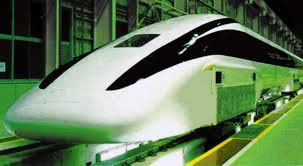Although I would not claim to be a great joiner I was in fact involved with delivering the petition in support of the MagLev (Very Fast Train) to the steps of the State Parliament House in 1998.
And I guess I was not the only one stirred into action fifteen years ago since I can still clearly remember cheerfully travelling up to Macquarie Street by chartered bus shoulder to shoulder with a bunch of usually surly trade unionists, other members of the local business community and a gaggle of activists of diverse political persuasions.
It was vaguely reminiscent of those stories you used to read about soldiers from both sides of the conflict during the Great War playing a game of friendly football or cricket during a temporary truce and (call me sentimental) I do remember thinking to myself at the time … this is a really nice change.
But what I’m really saying, 15 years on, is Wollongong definitely wanted a VFT then (as now) simply because everyone knew in their heart of hearts the area was screaming out for a decent rail service.
No one, I mean literally no one, was opposed to it.
It is totally unacceptable to have trains running slower now than they did 100 years ago and I can only hope that the bureaucrat, or was it some high-paid marketing consultant, who dreamt up the idea of improving the perception of train punctuality by actually slowing the services down, has taken his/her ill-gotten gains and buggered off.
With both the 99-year port leases now in place the NSW state government has 5 billion more reasons to actually deliver some real improvement to the region’s train services.
As it stands, the Port Kembla port terminal will inevitably get busier (and more profitable) in private hands which will quickly translate into more traffic – road and/or rail.
Which means, if the state government does nothing other than commission another report, we will in fact be worse off than we were 115 years ago rail-wise.
What this sorry tale does tell us is that Wollongong rarely gets what Wollongong needs. And that’s not right and should be changed.
What we need spelled out by all levels and sides of government is where they expect/hope Wollongong will be in 50 years’ time.
Let’s be frank, they’ll probably do that part … after all it’s just another report, but the bigger issue will be setting an agreed bi-partisan time frame for execution.
Of course, this is where it all starts to get too hard. An agreed vision has to be driven (if not conceived there) top down – if it is ever to be delivered.
And the first thing decision-makers (on all sides of politics) should take on board is ridding themselves of this myopic fascination with short term-ism. After all, they’re meant to be the visionaries who translate our hopes for the future into reality.
If the voters simply wanted their budgets to always balance they would surely elect suitably qualified managers or accountants to run the country, not untrained politicians.
What we need is a clear picture of what locals want and expect Wollongong to look like, and live in, 50 years on.
For starters:
• Will it still have a steelworks?
• Will it have a viable university?
• What about roads and rail infrastructure?
• How many people will live locally?
• What will be the age make-up?
• How many will work here and/or commute?
• Will the NBN affect these different scenarios?
Once we have a grasp of all of this we can start to think about what is needed to fund the vision.
We are facing an extremely important election within months now and the facts are we have the definite prospect of not seeing another change of government at state or federal level for at least 2-3 terms.
Now is the time the electorate needs to forget politics and past allegiances and take a realistic look at who will actually deliver what the region wants in the coming decades.
The facts are, in the past neither of the major parties really delivered for us when it came to infrastructure, so neither one holds the higher moral ground here.
As a consequence if neither of the majors can come up with acceptable long-term transport infrastructure solutions in the coming months our only option may be to take a serious look at embracing independents state and federal.(Heaven forbid, Frank Arkell re-visited). Of course, the Tasmanian solution or getting cosy with the Greens, Shooters, Bob Katter or other so-called loonies may not appeal to everyone (or anyone for that matter) but the region as a whole cannot just go on doing the same ole same ole and expect a different result. As we all know, that’s Albert Einstein’s classic definition for insanity.
Bottom line is if we seriously want something different we should be getting as mad as hell … not just going mad!
CONTRIBUTOR – Drew Martin: Historical construction equipment is the on-going fascination of this Wollongong based and now retired earthmover. And it was this strange obsession, together with senior links with the industry and the characters within it, that were the catalyst for his professional writing career and the original reason for adopting a pen name. After appearing each month for nearly a decade with his popular and always controversial Ripping Yarns column in the trade magazine The Earthmover & Civil Contractor Drew next tried his hand at childrens books with his REX-3 The Robot Excavator series being published well before Bob the Builder first appeared on book shelves. In recent years DM has largely turned his attention online and continues to amuse a younger audience with his original way of looking at what most other people consider completely normal life.
Comments
Powered by Facebook Comments
